IDT Technology THR122NX-01 Remote Thermometer User Manual MTR661
IDT Technology Limited Remote Thermometer MTR661
User Manual

EN
1
CONTENTS
Contents ................................................................... 1
Introduction .............................................................. 2
Product Overview .................................................... 3
Front View.............................................................. 3
Back View .............................................................. 4
Remote Sensor (THR122NX) ................................ 5
Getting Started ......................................................... 6
Batteries ................................................................. 6
Table Stand or Wall Mount ..................................... 6
Remote Sensor (THR122NX) ................................... 6
Setup Sensor ......................................................... 7
Data Transmission ................................................. 8
Search for Sensor .................................................. 8
Temperature .............................................................. 8
Select Temperature Unit ........................................ 8
Minimum / Maximum Records ............................... 8
Temperature Trend ................................................ 8
Reset System ........................................................... 9
Safety and Care ........................................................ 9
Warnings ................................................................... 9
Troubleshooting ....................................................... 9
Specifications ......................................................... 10
Main Unit Dimensions .......................................... 10
Remote Sensor Dimensions ................................ 10
Temperature ......................................................... 10
Remote Sensor (THR122NX) .............................. 10
Power ................................................................... 10
FCC Statement ....................................................... 11
Declaration of Conformity ..................................... 12

2
INTRODUCTION
Thank you for selecting the RadioShack Wireless
Thermometer (MTR661). This device bundles precise
temperature monitoring features into a single tool you
can use from the convenience of your home.
In this box, you will find:
•Main unit
•Remote sensor (THR122NX)
Keep this manual handy as you use your new product.
It contains practical step-by-step instructions, as well
as technical specifications and warnings you should
know.
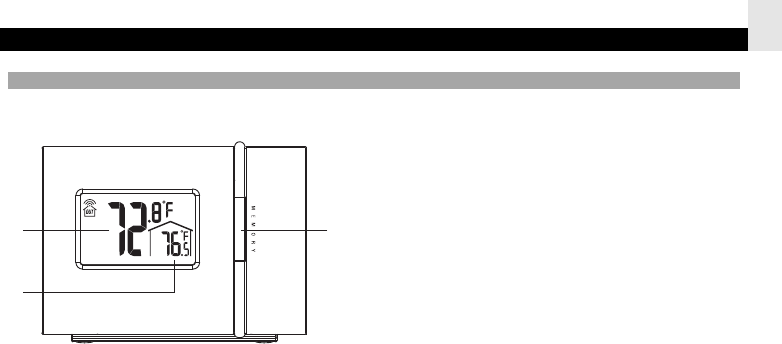
EN
3
PRODUCT OVERVIEW
FRONT VIEW
1. Outdoor Temperature Area
2. Indoor Temperature Area
3. MEMORY: view current, maximum and minimum
temperature readings
13
2
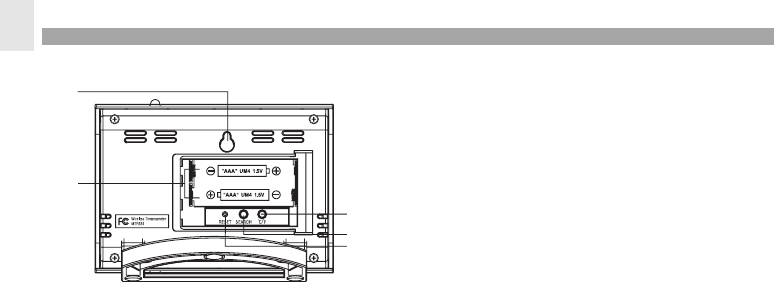
4
BACK VIEW
1. Wall mount
2. Battery compartment
3. RESET hole
4. SEARCH: Press to initiate signal sending between
main unit and sensor
5. ºC / ºF switch
REMOTE SENSOR (THGR122N)
GETTING STARTED
2
3
4
5
1
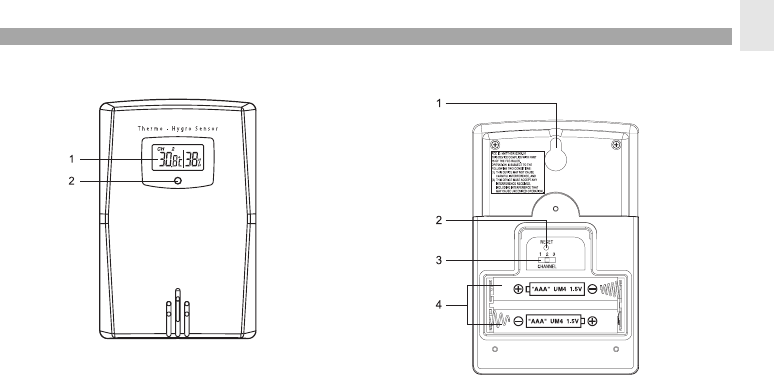
EN
5
REMOTE SENSOR (THR122NX)
1. LCD display
2. LED status indicator
1. Wall mount hole
2. RESET
3. Channel number (1 - 3)
4. Battery compartment
(Battery compartment cover not shown)
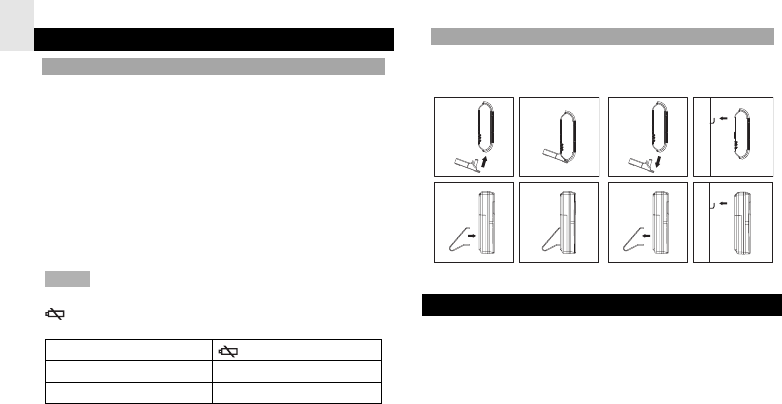
6
TABLE STAND OR WALL MOUNT
Use the stand on the back of the product, or mount it on
a wall with a nail.
GETTING STARTED
BATTERIES
Batteries are not supplied with this product. You will need
to purchase 2 x UM-4 (AAA) 1.5V alkaline batteries for
the main unit, and 2 x UM-4 (AAA) 1.5V alkaline batteries
for the remote sensor.
Insert batteries before first use, matching the polarity as
shown in the battery compartment. For best results, install
batteries in the remote sensor before the main unit. Press
RESET after each battery change.
Do not use rechargeable batteries.
NOTE
shows when batteries are low.
UNIT LOCATION
Main Indoor Temperature / Area
Remote Outdoor Temperature / Area
REMOTE SENSOR (THR122NX)
This product is shipped with a THR122NX Thermo
Sensor that collects Temperature data. Data can be
collected from only 1 sensor.

EN
7
SETUP SENSOR
1. Open the remote sensor battery compartment with
a small Phillips screwdriver.
2. Insert the batteries, matching the polarity as shown
in the battery compartment.
3. Selec any channel.
4. Place the sensor near the main unit. Press RESET
on the sensor. Then, press and hold SEARCH on
the main unit to initiate signal sending between the
sensor and the main unit. The reception icon on
the main unit will blink for approximately 3 minutes
while it is searching for the sensor. (Refer to the
Data Transmission section for more information.)
5. Close the remote sensor battery compartment.
6. Secure the sensor in the desired location using the
wall mount or table stand.
For best results:
•Insert the batteries and select the channel before
you mount the sensor.
•Place the sensor out of direct sunlight and
moisture.
•Do not place the sensor more than 98 feet
(30meters) from the main (indoor) unit.
•Position the sensor so that it faces the main
(indoor) unit, minimizing obstructions such as
doors, walls, and furniture.
•Place the sensor in a location with a clear view
to the sky, away from metallic or electronic
objects.
•Position the sensor close to the main unit during
cold winter months as below-freezing
temperatures may affect battery performance and
signal transmission.
You may need to experiment with various locations to
get the best results.
Standard Alkaline batteries contain signifcant amounts
of water. Because of this they will freeze in low
temperatures of approximately 10ºF. Disposable Lithium
batteries have a much lower threshold for temperature
with an estimated freezing range of below -40ºF. The
Liquid Crystal Display in outdoor thermometers will
remain operational to -20ºF with adequate power.
Wireless ranges can be impacted by a variety of factors
such as extremely cold temperatures. Extreme cold may
temporarily reduce the effective range between the
sensor and the base station.
If the unit's performance fails due to low temperature,
the unit will resume proper functioning as the
temperature rises to within the normal temperature range
(i.e no permanent damage will occur to the unit due to
low temperatures).
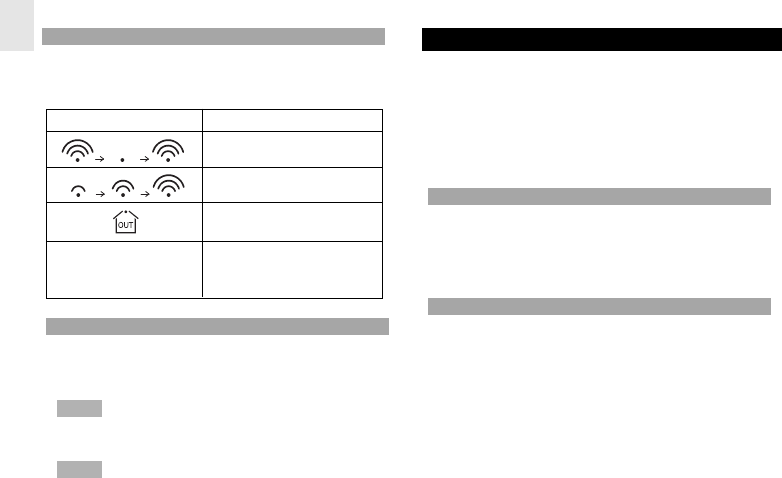
8
TEMPERATURE
This product can display current, minimum, and maximum
temperatures collected by the remote sensor and main
(indoor) unit.
Outdoor data is collected and displayed every 80
seconds. Indoor data is collected and displayed every
10 seconds.
SELECT TEMPERATURE UNIT
Press the ºC / ºF switch into the desired location. The
switch is located in the main unit battery compartment.
The setting for the main unit overrides the remote sensor
setting.
MINIMUM / MAXIMUM RECORDS
Press MEMORY to toggle between current, maximum
(MAX) and minimum (MIN) records. To clear the records,
press and hold MEMORY for 2 seconds. A beep will
sound to confirm that the memory has been cleared.
SEARCH FOR SENSOR
To search for a sensor, press and hold SEARCH for
2 seconds.
If the sensor is still not found, check the
batteries, obstructions, and remote unit location.
Signals from household devices such as
doorbells, electronic garage doors, and home security
systems may cause temporary reception failure. This
is normal and does not affect general product
performance. The reception will resume once the
interference ends.
DATA TRANSMISSION
Data is sent from the sensor every 80 seconds. The
reception icon shown in the Outdoor Temperature
Area shows the status.
--- shows in Outdoor
Temp Area
ICON DESCRIPTION
Main unit is searching for
sensor.
A channel has been found.
Channel 1 is selected
The selected sensor cannot
be found. Search for the
sensor or check batteries.
NOTE
NOTE

EN
9
RESET SYSTEM
The RESET button is located main unit battery
compartment. Press RESET when you change the
batteries and whenever performance is not behaving
as expected (for example, unable to establish radio
frequency link with remote sensor).
When you press RESET, all settings will return
to default value, and you will lose all stored information.
SAFETY AND CARE
Clean the product with a slightly damp cloth and alcohol-
free, mild detergent. Avoid dropping the product or placing
it in a high-traffic location.
WARNINGS
This product is designed to give you years of service if
handled properly. Observe the following guidelines:
•Never immerse the product in water. This can cause
electrical shock and damage the product.
•Do not subject the main unit to extreme force, shock,
or fluctuations in temperature or humidity.
• Do not tamper with the internal components.
•Do not mix new and old batteries or batteries of
different types.
NOTE
•Do not use rechargeable batteries with this product.
•Remove the batteries if storing this product for a
long period of time.
•Do not scratch the LCD display.
Do not make any changes or modifications to this
product. Unauthorized changes may void your right to
use the product. The technical specification of this
product and contents of this user guide are subject to
change without notice. Images not drawn to scale.
TROUBLESHOOTING
Check here before contacting our customer service
department.
Temp Shows "LLL"
or "HHH"
Temperature is out-of-
range
Check batteries
Check location
Remote
sensor
Cannot locate
remote
sensor
Problem Symptom Remedy
Data does
not match
main unit
Initiate a manual sensor
search
Remote
sensor

10
SPECIFICATIONS
MAIN UNIT DIMENSIONS
L x W x H 4 x 0.8 x 3 inches
(104 x 22 x 75 mm)
Weight 7.1 ounces (202 g)
with battery
REMOTE SENSOR DIMENSIONS
L x W x H 3.6 x 2.4 x 0.79 inches
(92 x 60 x 20 mm)
Weight 2.22 ounces (63 g)
without battery
TEMPERATURE
Unit ºF or ºC
Indoor Range 50 ºC to -5 ºC
(122 ºF to 23 ºF)
Outdoor Range -4 ºF to 140 ºF
(-20 ºC to 60 ºC)
Resolution 0.2 ºF (0.1 ºC)
REMOTE SENSOR (THR122NX)
RF frequency 433 MHz
Range 98 feet (30 meters)
with no obstructions
Transmission Every 80 seconds
Channel No. 1
POWER
Main unit batteries 2 x UM-4 (AAA) 1.5V alkaline
Sensor batteries 2 x UM-4 (AAA) 1.5V alkaline

EN
11
FCC STATEMENT
This device complies with Part 15 of the FCC Rules.
Operation is subject to the following two conditions:
(1) This device may not cause harmful interference, and
(2) This device must accept any interference received,
including interference that may cause undesired
operation.
WARNING Changes or modifications to this unit not
expressly approved by the party responsible for
compliance could void the user's authority to operate
the equipment.
NOTE This equipment has been tested and found to
comply with the limits for a Class B digital device,
pursuant to Part 15 of the FCC Rules. These limits are
designed to provide reasonable protection against
harmful interference in a residential installation.
This equipment generates, uses and can radiate radio
frequency energy and, if not installed and used in
accordance with the instructions, may cause harmful
interference to radio communications. However, there
is no guarantee that interference will not occur in a
particular installation. If this equipment does cause
harmful interference to radio or television reception,
which can be determined by turning the equipment off
and on, the user is encouraged to try to correct the
interference by one or more of the following measures:
• Reorient or relocate the receiving antenna.
•Increase the separation between the equipment
and receiver.
•Connect the equipment into an outlet on a circuit
different from that to which the receiver is
connected.
•Consult the dealer or an experienced radio/TV
technician for help.

12
DECLARATION OF CONFORMITY
The following information is not to be used as contact for
support or sales.Please call our customer service number
(listed on our website at www.oregonscientific.com),or on
the warranty card for this product)for all inquiries instead.
We
Name: Oregon Scientific, Inc.
Address: 19861 SW 95th Place, Tualatin,
Oregon 97062 USA
Telephone No.: 1-800-853-8883
Fax No.: 1-503-684-8883
declare that the product
Product No.: MRT661
Product Name: Wireless Thermometer
Manufacturer: IDT Technology Limited
Address: Block C, 9/F, Kaiser Estate, Phase 1,
41 Man Yue St., Hung Hom, Kowloon,
Hong Kong
is in conformity with Part 15 of the FCC Rules. Operation
is subject to the following two conditions:
1) This device may not cause harmful interference.
2) This device must accept any interference
received, including interference that may cause
undesired operation.